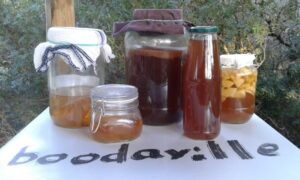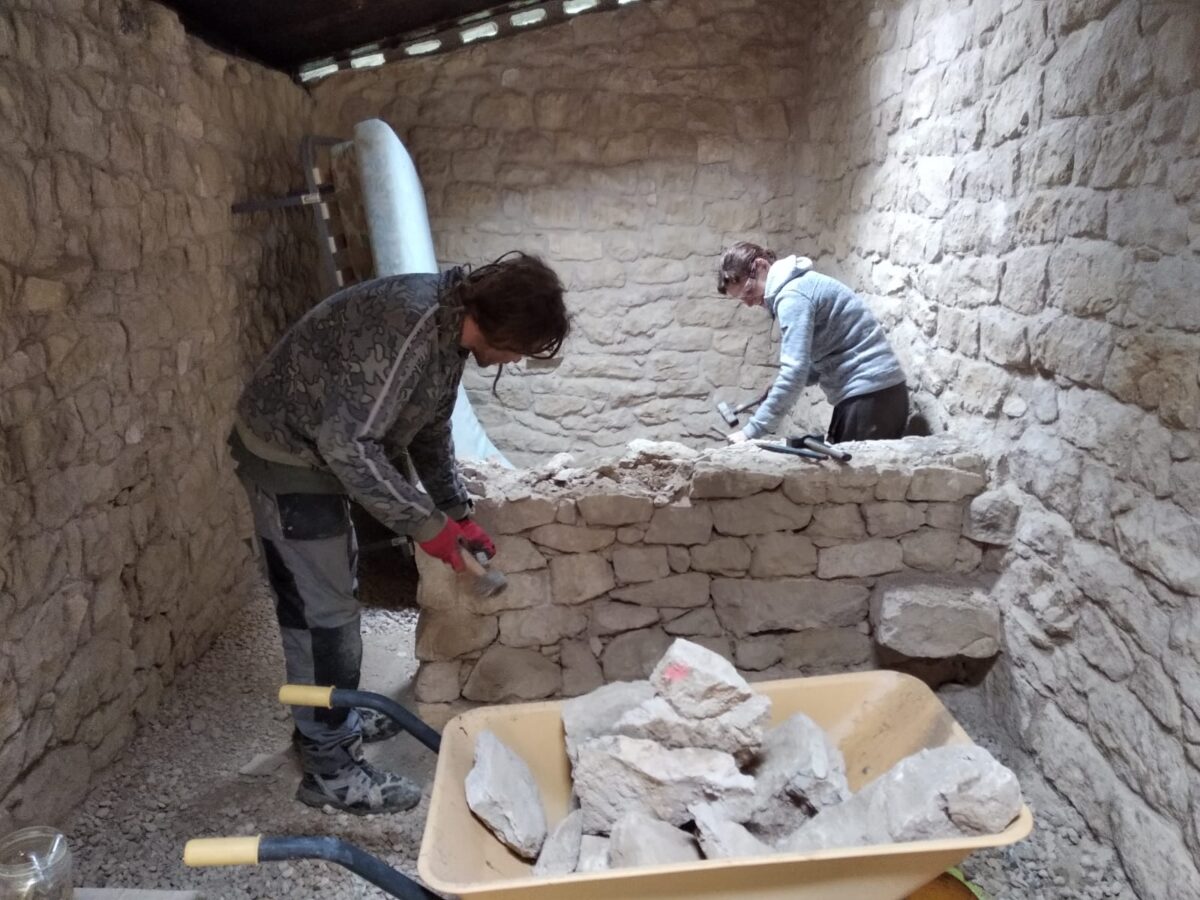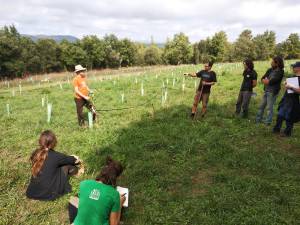
2019 ESC Volunteer Project
We are here!
Posted on May 10, 2019
Dear readers of this Boodaville blog,
Together with spring the Boodaville season has started in April. But our adventure as ESC volunteers at Boodaville has just begun. Adam, Maria, Santiago and me, Inge, have been selected as this years long-term volunteers with Claudia and Gala as our much needed mentors. We are all super excited and honoured to become a part of this beautiful place and meet all the amazing people connected to it. For the coming seven months we will live at Boodaville and in Caseres. We will be working on the site, be active on social media and hope to become part of, and make new, networks with other permaculture projects.
For me personally these first two weeks as a Boodaville volunteer have already made a huge impact on me. Meeting my fellow volunteers, Claudia, Anna, and all the others who are passionate about permaculture and Boodaville has been the best of experiences. Leaving my old life, my family and friends behind for seven months has been both exciting and hard. Jumping into an unknown situation like this project should be. I can now honestly say that having the right people around you makes taking a huge step like this so much easier. The philosophy of permaculture is not only obvious in the way Boodaville is designed but also in the way we work together as a group. We seek solutions instead of focusing on the problems. Our differences are not important, we all respect each other and focus on those things that connect us.
So please follow us if you are interested in our journey and the amazing thing we are planning this season for Boodaville. We will post content on this blog, Instagram, Twitter, Youtube and Facebook. We will also be present at the coming Maranya festival. Hope to see you there!
Life of a Boodaville volunteer: May
Posted on Jun 17, 2019
So I here am, one month into my adventure. An adventure I share with my fellow volunteers, our mentor and our growing Boodaville family. A seven months journey into permaculture. A month does not seem much. Its only four weeks. Thirty one days of working in the morning, eating and relaxing in the afternoon and working some more in the cooling evening. All this while enjoying nature 24/7. The month May felt like a lifetime to me, but in the best way.
I learned that permaculture is based upon three principles: care for the Earth, fair share and caring for people (and animals!). When applying for this project I imagined most of my learning would be in caring for the Earth. And I have learned a lot, I learned how to use zais systems to regenerate the earth and get rid of your compost, how worms are not disgusting but beautiful hard working creatures. I learned that nature as a design inspiration leads to impressive gardens like our own Boodaville food forest. Also when you cut grass it gives the nutrients a chance to return to the Earth. A month ago cutting grass seemed to me a waste of time but I now consider it to be my new hobby.
But the thing I truly learned a lot about is caring for others (both people and animals). The sharing circles though often emotionally draining have made me realize many things about myself and others. And help me accept some of those. Living in a group, a community, a wolf pack, has both been amazing but also challenging. The key to being a successful group is not to never have friction but how you handle it. Storms may be gathering, rain may fall, it’s good for growing.
Last week I was asked if I have a motto. I found out that I do. “Perfection does not exist.” But striving for perfection is a noble cause. To me, permaculture seems a great way to at least try.
Thank you Boodaville for welcoming me so full of kindness!
Posted on Oct 23, 2019
“Everything that is really, really great and inspiring is created by the individual who can labor in freedom” – Albert Einstein
My first impression about Boodaville as a volunteer: Arrive – Breath – Stop your thoughts – Start working from inner silence. The first half of the day I spent with daily tasks of the very basic life in boodaville with feeding the worm compost, chickens, making wood chips for the food forest, cooking, having inspiring conversations with other volunteers,… The second half of the day I had the freedom to work on my inner processes. Everyone does this in a different way. I chose reading and meditating. Others use their time to learn Spanish or connecting with the land by riding a bike. So there is a lot of space of self-development, which creates amazing conversations and projects from everyone! On the weekend we had a great tree planting project going on. I learned about permaculture-principles and step by step we tried to bring the soil alive again, from really harsh conditions, the cultural way of farming have left for us.
In general I feel Boodaville is a place you can learn to build a new form of living together as society and learn to come back to your basic needs, slowing down from stressful life and reconnect with the environment by working with the land.
I really appreciate the people I met and the awareness of the freedom to choose every second from now on! People I met and the awareness of the freedom to choose every second from new on!
Sense of an ending, Boodaville 2019 (by Inge)
Posted on Jan 24, 2020
From the beginning of May until the end of November I was one of the lucky few who had the opportunity to work and live in Boodaville as part of my ESC project. Now my beautiful, intense, exhilarating, often frustrating and completely inspirational time in Boodaville has ended. Before I came to Boodaville I dreamed to one day be able to lead a sustainable, self-sufficient life. I dreamed about finding my place in this world. Finding people I can connect with on deep levels. Learning all the practical things I felt I did not learn in school. And hoped to have fun while doing all of this.
Boodaville made it possible for all the things I had dreamed about for so many years to become reality. The last seven months I learned to live without running water and electricity. I learned to take care of our gardens. How the plants actually look that provide us with food. I learned not to be disgusted by compost toilets. To see my human waste not as filthy, but as part of me and a vital fertilizing part of our ecosystems. Reality however brings with it negative things that did not appear in my dreams. There can be no good without the bad. And if you do not let the bad happen a lot of good things will also not happen. I had to accept sides of me I could ignore in my old life. I had to face frustration and pain. Not only my own but those of everyone in my community. And where there is a group of people, especially a group like ours with strong personalities, each from different backgrounds, different cultures, well conflicts will just arrive. You cannot help it. And maybe we should not want to. Because conflicts do not need to be bad, do not need to create pain, create division. They are a sign that people care. And when well handled they made us stronger. And while learning all of this, I had the best time of my live.
So I guess all that is left for me to say is thank you. The Boodaville site is a beautiful mixture and monument of all volunteers that passed through it. Boodaville as a place is simply amazing, and Anna deserves all our praise and gratitude for bringing it into existence. Matarranya and Terra Alta are both stunningly beautiful regions inhabited by the most generous and friendly people. Who welcomed me and the rest of our crew with love, food and a lot unasked but needed advice. I need to thank my fellow volunteers. The ones that were there with me from beginning until the end. And the ones that spent time with us. I am going to need years to truly realize how much you taught me. These months would not have been as amazing if you had been different people. So really thanks to everyone I met. Who proved to me that there are a lot of people that care. Care about our planet, about nature, about all animals and other living thing.









